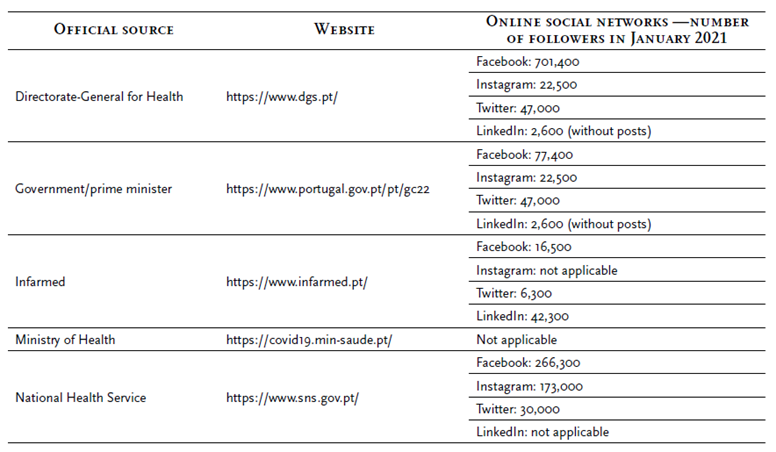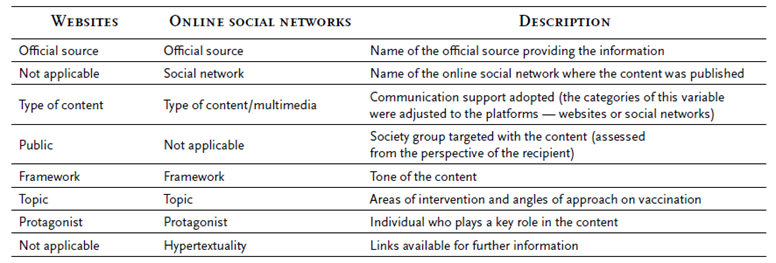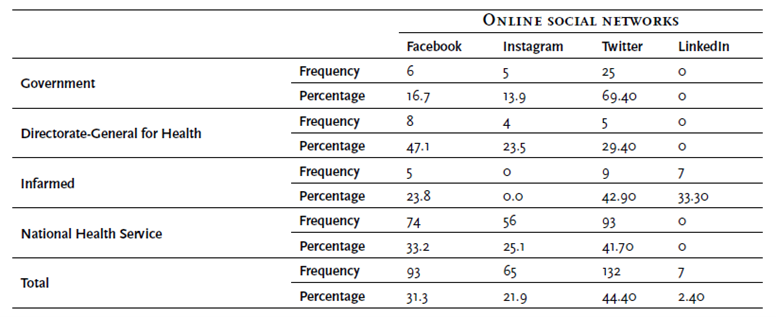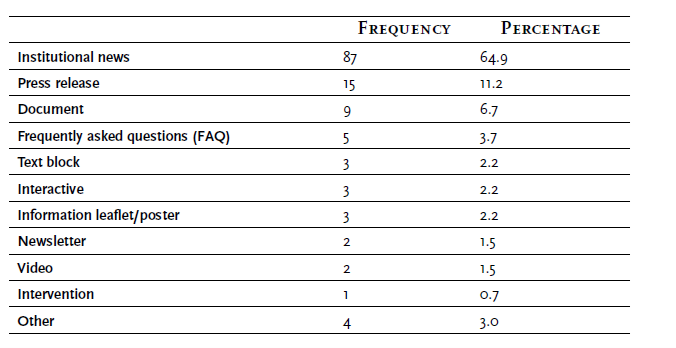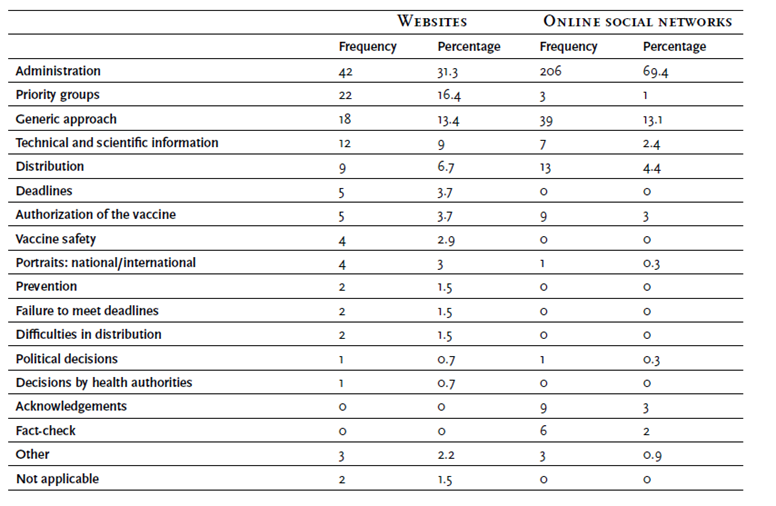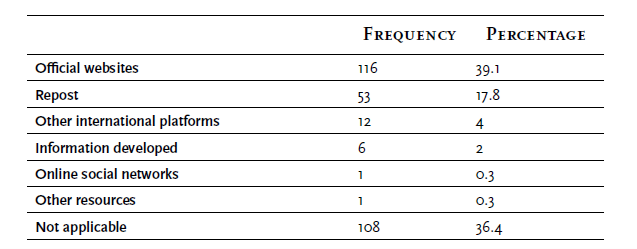Services on Demand
Journal
Article
Indicators
-
 Cited by SciELO
Cited by SciELO -
 Access statistics
Access statistics
Related links
-
 Similars in
SciELO
Similars in
SciELO
Share
Revista Lusófona de Estudos Culturais (RLEC)/Lusophone Journal of Cultural Studies (LJCS)
Print version ISSN 2184-0458On-line version ISSN 2183-0886
RLEC/LJCS vol.8 no.2 Braga Dec. 2021 Epub May 01, 2023
https://doi.org/10.21814/rlec.3593
Varia
Vaccination Against Covid-19 - An Analysis of Portuguese Official Sources’ Digital Health Communication
1Centro de Investigação em Tecnologias e Serviços de Saúde, Faculdade de Medicina, Universidade do Porto, Porto, Portugal
2Centro de Estudos Interdisciplinares, Faculdade de Letras, Universidade de Coimbra, Coimbra, Portugal
3Centro de Estudos de Comunicação e Cultura, Faculdade de Ciências Humanas, Universidade Católica Portuguesa, Lisboa, Portugal
4Centro de Estudos de Comunicação e Sociedade, Instituto de Ciências Sociais, Universidade do Minho, Braga, Portugal
The covid-19 pandemic poses complex challenges to governments and health authorities all around the globe. Institutions have to cope simultaneously with the efforts to control the dissemination of the disease and the need to undertake articulated health communication procedures. This communication process is challenging to manage, due to the considerable uncertainty of the available information, the increase in misinformation stemming from a scattered (and often unmediated) mediascape, and some social groups’ resistance to adhere to the recommended preventive measures. Vaccination emerges as a topic that fuels extreme positions - on the one side, the eagerness for vaccine availability (which encourages illicit attempts to get it); on the other, the obstinate refusal of vaccination (based on theories with no medical-scientific grounds). In this context, we aim to assess how the leading Portuguese governmental and health institutions communicate with their audiences in the digital environment through their official websites and online social networks. In five websites and four online social networks used by the chosen sources, we have collected the content about vaccination published between the announcement of the authorisation of the first vaccine and the beginning of the administration of the second round to health professionals. Then we have applied content analysis methodology to the corpus of this case study. The results have shown that the primary Portuguese official sources give themselves the floor regarding the covid-19 vaccination process, addressing three main themes using an eminently informative frame: vaccine administration, priority groups definition and a general approach to the vaccine. Bearing in mind health communication’s primary goals
engage, empower and influence citizens - we conclude that Portuguese official sources have promoted conservative forms of communication, potentially missing the opportunity to foster a more pedagogical and customised digital communication.
Keywords: covid-19; vaccination; official sources; health communication; strategic communication
A pandemia por covid-19 tem colocado complexos desafios às instituições governamentais e de saúde em todo o mundo. Para além da dificuldade em controlar a disseminação da in feção, as instituições têm de encetar um processo de comunicação de saúde particularmente difícil de gerir, por causa do elevado grau de incerteza associado à informação de que dispõem, do aumento da desinformação resultante de um ambiente mediático pulverizado (e, muitas vezes, sem mediador) e da resistência de alguns grupos da sociedade em aderir às medidas preventivas recomendadas. A vacinação surge, pois, como um tema que alimenta posições extremas - desde a ânsia pela sua disponibilidade (que potencia tentativas ilícitas de obtenção da vacina) até à sua recusa intransigente (baseada em teorias sem fundamentação médico-científica). Neste enquadramento, pretendemos avaliar a forma como as fontes oficiais - as principais instituições governamentais e de saúde portuguesas - comunicam com os seus públicos em ambiente digi tal, nomeadamente através dos websites e das redes sociais online. Para isso, foram recolhidos os conteúdos sobre vacinação publicados em cinco sites e quatro páginas nas redes utilizadas pelas fontes analisadas, no período compreendido entre o anúncio da autorização da primeira vacina e o arranque da administração da segunda dose aos profissionais de saúde. O material em estudo foi examinado através de técnicas de análise de conteúdo. Os resultados revelaram que as principais fontes oficiais portuguesas chamam a si o protagonismo em torno da vacina ção contra a covid-19, que declinam em três temas fundamentais - administração, definição de grupos prioritários e abordagens genéricas, através de conteúdos com um enquadramento maioritariamente informativo. Atendendo a que a comunicação de saúde tem como objetivos envolver, capacitar e influenciar os indivíduos, concluímos que as fontes oficiais promoveram formas de comunicação conservadoras, perdendo potencialmente a oportunidade de fomentar uma comunicação em ambiente digital mais pedagógica e personalizada.
Palavras-chave: covid-19; vacinação; fontes oficiais; comunicação de saúde; comunicação estratégica
Introduction
At the end of 2020, after the world had suffered an annus horribilis due to the covid-19 pandemic, which in December totalled nearly 2,000,000 deaths worldwide (Center for Systems Science and Engineering, 2021), finally hope is reborn. Months after an unprecedented investment in medical-scientific research to find a solution that could stop the spread of SARS-Cov-2, the first vaccine against covid-19 is authorized.
In Europe, the European Medicines Agency gave the “green light” on December 21, 2021. That led to the European Commission’s swiftness in authorizing the marketing and distribution of the vaccines in all 27 member states. The President of the European Commission, Ursula von der Leyen, announced that the vaccination process would be concerted, starting between December 27 and 29, 2020, in all 27 countries. For a while, the media and social narrative changed. The vaccine - product of the medical-scientific capacity of the old continent - and European coordination brought hope, a word much repeated in the following days.
Also, in Portugal, a country afflicted by the excessive mortality linked to the pandemic and the ageing population (around 115,000 deaths in 2020, a number unheard since 1949; Guedes, 2020), the vaccine received the most media and social attention. The official sources (associated with governmental and health institutions) involved in the complex vaccination campaign, whose imminent process carefully prepared the scenarios and strategically conveyed their messages to journalists eager for information and a society thirsty for good news on health.
However, although undeniably relevant, traditional media are not the only communication channel used by institutional sources to communicate with different groups in society. In the current “disintermediated” media panorama (Eldridge et al., 2019; Lévy, 1998), digital communication, namely through websites and online social networks, assumes a strong relevance that should be analyzed. What health communication did official sources promote there?
Theoretical Framework
Health Communication
Health communication is still a recent discipline, which has evolved at different
paces in different regions of the globe and has received the most attention in the United States of America. However, even if it is still a “pre-paradigmatic” area (Araújo, 2017), its relevance is unquestionable (Ishikawa & Kiuchi, 2010) and has been reinforced with the advancement of the global pandemic by covid-19 (Fielding, 2020; Finset et al., 2020).
Health communication is a crucial strategy for informing the public about health concerns and keeping essential health issues on the public agenda (World Health Organization, 1998). The World Health Organization (WHO) argues that to be effective, this type of communication should be (a) accessible and applicable; (b) credible and reliable; (c) relevant, (d) timely, and (e) understandable by decision-makers (World Health Organization, n.d.).
Renata Schiavo (2014) adds a refreshing perspective, explaining that one of the main goals of health communication should be to “engage, empower, and influence” individuals and communities (p. 5). In other words, the ultimate goal of health communication is to promote behavioural maintenance or change that aligns with the promotion of individuals’ health.
Within the framework of a pandemic and despite the absolute value of the different levels of health communication involving many different agents (interpersonal, group, and other), the social level demands more significant effort. It is where the most noticeable results are expected. Kreps (2001) describes this level of communication as focused on creating, disseminating, and using health information communicated through vari ous media to a wide range of professional and lay audiences in society, which influence health education and promotion practices (p. 235).
Thus, the focus should be more robust at this level because it can impact a wide range of audiences (Goldberg et al., 2015). Let us think about one of the health crises over the last decade, such as the ebola outbreak in 2014, for example. It is enough to understand how essential health communication at the social level is to inform populations from various countries, condition behaviours and thus make the population an ally in maintaining their health security, promoting the containment of an epidemic through preventive behaviours. It was also within this level of communication that what may have been the most transversal health communication campaign in the world - the campaign against covid-19 - was put into practice.
However, for health communication campaigns to be efficient, they must be well designed and rigorously targeted, through the most appropriate channels, and with a frequency that allows the message to be received, assimilated, and remembered (Abroms & Maibach, 2008, p. 221). As far as covid-19 is concerned, we cannot claim there has been a real campaign, despite the efforts made in this sense, particularly on the part of the WHO. Furthermore, the pandemic’s extent and the lack of scientific evidence on the virus’ nature and behaviour led to many assumptions of what should be a health communication being forgotten, lost in the flood of uncertainty. The zika epidemic between 2015 and 2016 had proven a tendency to spread misinformation1 in the absence of confirmed information about the disease (Vraga & Jacobsen, 2020).
Given this health crisis scenario, with no solid scientific evidence to guide the political decision safely and clearly, society reacted, relentlessly seeking more information to adjust its behaviour and thus ensure its safety (Paakkari & Okan, 2020). As a result, the news media have become extremely important as indispensable partners in response to this public health emergency and as mediators between governments, health institutions and the public (Mheidly & Fares, 2020). Indeed, the public seeks “accurate information, sound scientific facts, government decisions and general public reactions” (Mheidly & Fares, 2020, p. 411) through the media and, increasingly, social media (Newman, 2020): the increase in news consumption during the covid-19 pandemic illustrates their centrality (Casero-Ripolles, 2020).
Vaccination - A Major Challenge for Health Communication
The vaccination process against covid-19 launched by the European Union on December 27, 2020, will be remembered as a response to the most significant challenge that humanity has faced in the first years of this century (Jeyanathan et al., 2020).
The communication of this campaign was itself an exceptional case that is worth evaluating. Across Europe, in a concerted fashion, official sources, media and society turned their attention to the vaccine. This long-awaited solution was capitalized politically by the European Commission and the governments of the European Union’s member countries. However, the communicative challenge posed by the vaccination campaign goes far beyond the political arena.
Communication was a crucial strategy in public health (Rudd & Baur, 2020), and its role in the vaccination campaign was immediately acknowledged as essential. In fact, within health communication, vaccination was a challenge in itself. It was one of the most studied topics due to its association with critical misinformation phenomena, which triggered anti-vaccination movements.
One of the causes of this problem was a scientific article published by Andrew Wakefield and other specialists in the renowned scientific journal The Lancet in 1998. The paper linked the MMR vaccine (against measles, epidemic parotitis, and rubella) to autism. Although the article was a case study with a sample of only 12 children, its results had an enormous impact on the community, namely due to the media coverage it received. Thus, between 2003 and 2004, the vaccination rate against measles, epidemic parotitis and rubella in 2-year-old children in the United Kingdom dropped to around 80% (Editorial Board, 2012). Although The Lancet removed the discredited article from its archives in 2010, the anti-vaccination movement kept growing (Arif et al., 2018).
As a result, as Renata Schiavo (2020) stresses, the media’s involvement in this process becomes fundamental, considering the role of journalists in ensuring accurate and evidence-based media coverage as very important and “training scientists and government agencies to discuss in plain language the benefits of a future vaccine for the COVID-19 with the media” (p. 74). Today, with the massive proliferation of online information, the risks associated with communication on vaccination are even higher. Data remains in an online environment, indelible, regardless of its quality, with consequences extending to various domains and hard to manage (Suiter & Culloty, 2021). Therefore, “counteracting misinformation on vaccines by health authorities is part of the solution” (Arif et al., 2018, p. 10).
Thus, the responsibility that falls on political and health authorities is exceptionally high. Apart from adequately promoting the reception, distribution and administration of the vaccine, they will have to rigorously and cautiously facilitate the communication process about the vaccine; otherwise, instead of ensuring the much-needed adherence to vaccination, they will “increase misconceptions or reduce the intention to vaccinate” (Nyhan et al., 2014, p. e835).
In their favour, official sources rely on the willingness of most citizens to be inoculated. According to a European study published as recently as 2020, 75% of the Portuguese admitted they want to be vaccinated (Neumann-Böhme et al., 2020). Communication about vaccination was therefore starting favourably.
Official Sources and Strategic Communication
In the media space, sources are the origin of the information we read, see and hear. According to Hall et al. (1978), the authoritative and objective sources represent the prominent social institutions, institutional power with representative status (members of parliament, ministers, trade unions, etc.), and experts.
Among the existing sources, the official ones hold a dominant position (Araújo, 2017; Lopes et al., 2015; Ribeiro, 2006; Santos, 1997). Studies in Portugal have revealed an elite of organized sources that define the health news (Araújo, 2017; Lopes et al., 2011), influencing the production of three out of 10 pieces of information on this subject in the national press (Magalhães, 2012).
The sources seek to increase their visibility, set the public agenda, gain support or adherence to ideas, prevent or repair damages, neutralize opponents’ interests, and create a positive public image (Pinto, 2000, p. 280). In other words, sources in general, and the authorities that we recognize as official sources, in particular, use their communication potential strategically, intentionally to fulfil a specific mission, crossing areas such as management, marketing, advertising and public relations (Hallahan et al., 2007).
Hence, strategic communication corresponds to unifying different communication actions designed to help achieve the strategic goals of a given entity, using the available forms of communication to meet its objectives, its tactics and action plans defining each of these forms (Carrillo, 2014).
Translating this to the challenge of implementing a generalized vaccination campaign that starts within a pandemic, we realize that adopting a communication strategy logic is essential for the authorities involved in the vaccination process to achieve their goals. Using media advisory strategies allows them to influence public opinion through traditional media and use “disintermediated” strategies (Eldridge et al., 2019; Lévy, 1998), namely in the digital environment, which facilitate a closer “dialogue” with different groups of society.
Methodology
This study aimed to understand the communication strategies adopted by official national sources to communicate on the covid-19 vaccination. It is part of a larger project seeking to analyze this topic through the media coverage of the covid-19 vaccination in the Portuguese media (namely in the news services of open signal generalist channels and the newspapers Público and Jornal de Notícias) and the strategic communication promoted by Portuguese and European official sources.
The relevance of digital communication in the current media and information panorama is undeniable (Neuman, 2016; Reyna et al., 2018), so official sources are increas ingly focusing on this type of communication by boosting their websites and their pages in the most active and closest to the public online social networks (Statista, 2021). In Portugal, users spend an average of 96 minutes per day browsing, which rises to 135 minutes among the youngest. Facebook still leads the chart, but Instagram is gaining ground, as 67% of Portuguese people, in 2020 used these platforms to consume information (Marktest, 2020). Between 2015 and 2020, according to the Reuters Institute Digital News Report 2020 (Newman et al., 2020), television has been challenged by online and social media, and smartphone use has grown steadily. From the standpoint of organizations with an online social media presence, 70% have a corporate page on Facebook, followed by LinkedIn (54%), Youtube (44%) and Twitter (42%). At the same time, Instagram stands out as the platform with the most significant growth potential (NOS, n.d.).
Building on these indicators, we analyzed the official websites and the online social networks accounts (Facebook, Instagram, Twitter and LinkedIn) of Directorate-General for Health (Direção-Geral da Saúde, DGS), government/prime minister; National Authority of Medicines and Health Products (Autoridade Nacional do Medicamento e Produtos de Saúde I.P., Infarmed); Ministry of Health; National Health Service (Serviço Nacional de Saúde, SNS). The selection of sources focused on identifying the authorities directly involved in the pandemic management and the public health response (Table 1).
For the Ministry of Health, we chose to analyze the website dedicated to covid-19, which included a microsite devoted to vaccination, since this was the Ministry of Health’s privileged platform for communicating with society on this topic. Moreover, the ministry did not have an account on online social networks.
The content related to covid-19 vaccination was mapped, selected and analyzed, totalling 134 occurrences on official websites and 297 posts on online social networks from December 21, 2020 - the day the first vaccine was authorized by the European Union - to January 21, 2021.
Analysis Grids and Variables
To analyze the content, we applied two analysis grids with a standard set of variables, adjusted according to the type of content analyzed (content published on a website or a post published on an online social network).
The grids were designed to identify the main characteristics of the content published by official sources, according to the variables presented in Table 2.
The data collected were then coded and categorized in SPSS, allowing for simple frequency analyses and crossing of variables, which contributed to a more extensive and in-depth understanding of the form, content and objectives of the communication strategies of the official sources selected on the topic under study.
Outcomes
Presence of Official Sources in Online Channels
More than half of our sample consisted of content communicated by the SNS through its website and online social networks pages. Looking at the websites, Infarmed is next on the list of most valuable sources for communicating new information on covid-19 vaccination, with a percentage of 20%, followed by the government (13%), the Ministry of Health’s website dedicated to the pandemic and vaccination (9%) and, finally, the DGS, whose content on this topic was only 8%. The behaviour of sources in online social networks is, however, different. The government holds a more prominent place, as it is the second most frequent source, accounting for 12% (Table 3).
Table 3 Covid-19 vaccination content published by official national sources on their websites and online social networks

Portuguese official sources focused their communication efforts on online social networks on Twitter (Table 4). The Portuguese government most used this platform, posting approximately 70% of its vaccination-related content on Twitter. However, the SNS added a higher number of occurrences on this network (n = 93). It is worth mentioning that the DGS opted for a different platform, favouring the use of Facebook (47%), although with a reduced number of posts in the sum of the four networks analyzed (n = 17).
Types of Content and Target Audiences
About 65% of the content produced by the official sources under study fall in the category of “institutional news”, with a very significant distance from the category “press release” (11%) that follows it (Table 5). Formal documents of official content account for 6.7%, followed by frequently asked questions (FAQ) with a percentage of 3.7%. We find content types such as information leaflets (2.2%), video (only 1.5%), and others with lower rates.
Text is the most common type of content in the posts published by the analyzed sources on their online social networks pages (60%), followed by banners (33%). The use of this type of content, with hints of advertising language, represents a significant result insofar as it disrupts the informative, almost journalistic language used, for instance, on websites. The banners frequently combine, in the same image, photo or illustration with persuasive messages and may derive from multimedia advertising campaigns (Table 6).
Table 6 Types of content published in the online social networks of official national sources
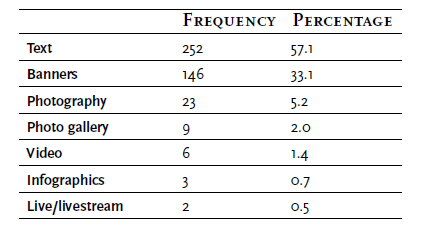
Note. Since online social networks content tends to have more than one type of content, we categorized the two dominant content types in each post. Therefore, the total number of records in this table exceeds the total number of posts analyzed.
It is worth mentioning that within the scope of the website’s analysis, we also assessed the target public of the published contents and concluded that 78.4% (n = 105) of the information was aimed at the general public. The contents addressed to health professionals and entities involved in the vaccination process added up to 11% (n = 14), along with the information made available to the media. This variable did not apply to online social networks content, as such content is expected to target a wider audience.
Framework
The official sources preferred an informative approach when communicating about vaccination against covid-19, followed by a positive direction, which accounted for 18% of the content published on the websites and 16% of the content posted on the social networks (Table 7). The educational framing was postponed to a later plan, adopted in only 4% of the cases concerning the websites and having no expression in the posts of the analyzed social networks. The contents with a persuasive or defensive approach were infrequent. However, it is essential to mention the DGS, which, among all sources, made the most use of the compelling approach, particularly in online social networks.
Topics
The content provided by official sources focused primarily on the routine administration of the SARS-Cov-2 vaccine. This topic underpinned one-third of the content published on the websites and about 70% of the posts published on the social networks we monitored. The groups defined as priority groups for their reception (16%) received special attention from the Portuguese official websites (16%). Still, curiously, the same did not happen on the online social networks, which only addressed this topic three times. More than 13% of the official sources’ communication addressed the vaccine from a generic perspective (giving an overview of the subject, without going into depth), both on websites and online social networks, with topics such as vaccine safety and the authorization for its administration remaining in the background (Table 8).
Protagonists
More than half of the content about vaccination published on the websites of the primary official sources does not focus on individuals who can assume a protagonist role (55%). As for online social networks, 77% of the content can relate to one or more protagonists (Table 9).
Table 9 Protagonists in content about covid-19 vaccination published on websites and online social networks

When there are protagonists, the official sources’ representatives take a prominent role on the websites, unsurprisingly (with a presence of 25% compared to the total and 56% compared to the contents with a protagonist). Citizens are outside the scope of these sources (they are not represented in 1% of the total contents published on the websites, and in the online social networks, they remain below 2%). Healthcare professionals are in the second visibility line on the websites (10%) and online social networks (14%).
Official sources do not enjoy the same prominence on online social networks. The prominence is chiefly shared (39%) among different players, and the posts that give an exclusive stage to official sources’ representatives are limited to about one-fifth of the cases (20%).
Hypertextuality
Only 64% of the posts about vaccination published on social networks show signs of hypertextuality. About 40% of the publications redirect followers to the official source websites, and 18% are content reposts, a strategy typically used on Twitter (Table 10).
Discussion
Our results show that the SNS is the official source that most favours communication on vaccination in the digital environment in the channels analyzed, through a fruitful publication of content on its website and the continuous publication of information on online social networks. Considering that society perceives the SNS as the enforcer of the Ministry of Health, this result seems expectable. It was an indicator of “good communicative health” on the SNS when it was constantly tested.
It is worth mentioning that the SNS was more proficient in producing and publishing content than the other official national sources analyzed. It stood out for employing a logic of proximity, echoing the progress of vaccination by region, in a clear intention to let all citizens, from north to south of the country and the islands, know that the vaccine would reach all areas. Titles such as “Vaccination Starts Today for Health Professionals in Tâmega and Sousa” and “Vaccination at ULS of Guarda”, identified in institutional news items on the SNS website, are proof of that. In other words, this is the source closest to citizens and the one most aware of the need to decentralize information. Therefore, the hospital centres and health units of the SNS can provide content that this source will replicate.
Still, when selecting online social networks to promote content on vaccination, this source favours Twitter. So do the government and Infarmed. The Ministry of Health does not have an account on this social network.
Twitter has around 199,000,000 daily users. In the first quarter of 2020, when the pandemic was decreed, in March, daily active users grew from 133,000,000 in the first quarter of 2020 to 162,000,000 users in the last quarter, up about 22 percent (Elfira & Indrawan, 2021).
However, we know that this is not Portugal’s most used online social network. Facebook and Instagram surpass it. According to a Marktest (2020) report, when asking the Portuguese which online social networks they know, Facebook has the most spontaneous references among respondents by 99.6%, followed by Instagram by 87.4% and Twitter by 60.1%.
Thus, why do official sources publish more insistently on Twitter? We can explore two interpretations. The first has to do with the features of this network which predispose to the publication of shorter but more frequent posts, making it possible to inflate the number of posts published. The second has to do with the audience: sources prefer to use this network because, in fact, more than communicating directly with citizens, they seek to speak with a vital target segment - journalists. We know that journalists are specially tuned to this network, following closely what official sources publish and looking for news information (Parmelee, 2013). Therefore, we point out that official sources may use online social networks as (yet) another media relations tool.
In the opposite direction to the SNS, the government and Infarmed, we find the DGS. This institution favoured Facebook, which is not surprising since it has 701,400 followers on this platform and only 47,000 followers on Twitter. This option allows the DGS to prioritize direct communication with citizens through online social networks, enabling more effectively delivering messages with a solid intent to induce behaviours and encourage vaccination. The results support this thesis, revealing that DGS published two-thirds of the posts with a persuasive tone. Still, the DGS may be underusing its communication capacity on Facebook since the total number of posts published on vaccination was relatively small.
Most of the content official sources published on their websites and online social networks were news-based. Besides the fact that 65% of the content disclosed by official sources on the websites were institutional news, we noted that, on social networks, posts are often composed of informative texts complemented by photos. Therefore, a news language underlying the sources’ contents in the digital environment may derive from the long tradition of media relations associated with the Portuguese official sources.
While the journalistic style is desirable in media relations work, it may not be the most adequate when the intention is to inform and persuade the message receivers to adopt a particular behaviour. Within the scope of our analysis of the online social networks contents, we realized that using a language closer to advertising only accounts for approximately 30% of the posts published on the networks, and these translate into banners similar to advertisements, duly adapted to the media, and adopted mainly by the SNS.
Considering the responsibilities of the official sources under analysis, one could have expected a more substantial effort to produce and promote content with an educational approach, more focused on educating and clarifying the population on topics that may compromise their adherence to vaccination. However, educational content did not find space on online social networks and accounted for only 4% of the content published on the websites.
Before the vaccine arrived in Portugal, 75% of the Portuguese assumed they wanted to be vaccinated (Neumann-Böhme et al., 2020). A significant percentage pointed to fears about the vaccine’s safety and possible side effects. However, this topic was one of the least covered by official sources when communicating in the digital environment. Vaccine safety was the focus of only four pieces of all content published on websites. The topic was almost wholly excluded from communication on vaccination, on the online social networks, during the period under analysis, reflecting an apparent avoidance of the subject.
In contrast, the strategy of the official sources focused on administration as proof of the vaccination campaign’s success. Administration, priority groups and generic approaches about the vaccine represent the dominant topics actively promoted by official sources in the digital outlets they control. In the future, we intend to assess to what extent these choices of topics correlate with the thematic approaches taken by journalists because we observe the influence of media relations techniques and objectives within the digital communication strategies of the sources under study.
The representatives of the official sources most often take the leading role in the contents published on the websites and, even on the online social networks, they take a prominent place in one-fifth of the posts, surpassing the health professionals, whose prominence lies between 10% and 14%. The office holders from the official sources analyzed are presented as the central agents of the vaccination process in a straightforward exercise of strategic communication with political intentions, which may reap dividends with public opinion.
Conclusions
Our work suggests that the primary Portuguese official sources lead the covid-19 vaccination process, which falls into three key topics - vaccine administration, defining priority groups and generic approaches. They do so through institutional news with a mostly informative tone on the websites. They use the same technique on the online social networks’ posts that rely on texts and photos, including hyperlinks that direct followers to official sites, often European entities.
According to our results, the SNS takes over as the main interlocutor of the Portuguese when it comes to covid-19 vaccination. However, despite the SNS being particularly prolific in the digital environment, doubts remain about this official source’s degree of coordination with the other analyzed authorities. In the future, it is necessary to evaluate the communication on vaccination of these sources from a multimedia perspective.
Media relations still strongly influence the communication promoted by official national sources in the digital environment. On social networks, sources communicate through Twitter, possibly to set traditional media’s agenda and influence opinion-makers, as citizens tend to prefer networks with other attributes.
The intense focus on the vaccine administration could suggest that the sources have let themselves be swept along by the media’s current affairs flow, centred on it. On the other hand, as we know that sources tend to be the main determinants of the information conveyed by the media, we suggest that the confluence on this topic is a strategic choice with political purposes. The administration of the vaccine represents an unprecedented success of European policies and influences the national policies of each European Union country. Capitalizing on this success means improving the political reputation of official sources and their representatives. In Portugal, this situation was made even more evident by the proximity of the Portuguese presidency of the Council of the European Union, starting a few days after the vaccination began.
The focus on vaccine administration went hand in hand with the undervaluation of other topics equally crucial from a health perspective but possibly less appealing from a political perspective, namely vaccine safety and possible distribution problems arising from lack of supply. Portuguese official sources did not actively and significantly promote content on these two essential topics in the digital channels analyzed. However, it was known that safety and side effects were of concern to some citizens and that the supply capacity of the pharmaceutical companies producing the vaccine might fall short. Assuming that these options may have been intentional, they suggest that official sources approach the communication process on vaccination from a political communication perspective and not from a health communication perspective.
Considering that health communication aims to “engage, empower and influence individuals and communities” (Schiavo, 2014, p. 5), we conclude that, during the period of analysis, official sources promoted conservative forms of communication, potentially missing the opportunity to foster a more direct, educational, interactive and personalized communication in the digital environment.
Acknowledgements
This work is supported by national funds through FCT - Fundação para a Ciência e a Tecnologia, I.P., under project UIDB/04255/2020 (base funding) and UIDP/04255/2020 (programmatic funding), project UIDB/00736/2020 (base funding) and UIDP/00736/2020 (programmatic funding), and within the scope of the contract signed under the transitional provision laid down in article 23 of Decree-Law no. 57/2016, of August 29, as amended by Law no. 57/2017, of July 19.
REFERENCES
Abroms, L. C., & Maibach, E. W. (2008). The effectiveness of mass communication to change public behavior. Annual Review of Public Health, 29(1), 219-234. https://doi.org/10.1146/annurev.publhealth.29.020907.090824 [ Links ]
Araújo, R. (2017). Dinâmicas de construção do noticiário de saúde: Uma análise da imprensa generalista portuguesa (Tese de doutoramento, Universidade do Minho). RepositóriUM. http://hdl.handle. net/1822/45761 [ Links ]
Arif, N., Al-Jefri, M., Bizzi, I. H., Perano, G. B., Goldman, M., Haq, I., Chua, K. L., Mengozzi, M., Neunez, M., Smith, H., & Ghezzi, P. (2018). Fake news or weak science? Visibility and characterization of antivaccine webpages returned by Google in different languages and countries. Frontiers in Immunology, 9, Artigo 1215. https://doi.org/10.3389/fimmu.2018.01215 [ Links ]
Carrillo, M. V. (2014). Comunicação estratégica no ambiente comunicativo das organizações atuais. Comunicação e Sociedade, 26, 71-80. https://doi.org/10.17231/comsoc.26(2014).2025 [ Links ]
Casero-Ripolles, A. (2020). Impact of covid-19 on the media system. Communicative and democratic consequences of news consumption during the outbreak. El Profesional de la Información, 29(2), Artigo e290223. https://doi.org/10.3145/epi.2020.mar.23 [ Links ]
Center for Systems Science and Engineering. (2021, 23 de janeiro). Covid-19 dashboard. Johns Hopkins Coronavirus Resource Center. https://coronavirus.jhu.edu/map.html [ Links ]
Editorial Board. (2012, 7 de dezembro). Measles vaccination rates in UK recover after 14 years. Vaccines Today. https://www.vaccinestoday.eu/stories/measles-vaccination-rates-in-uk-recover-after-14-years/ [ Links ]
Eldridge, S. A. II., García-Carretero, L., & Broersma, M. (2019). Disintermediation in social networks: Conceptualizing political actors’ construction of publics on Twitter. Media and Communication, 7(1), 271-285. https://doi.org/10.17645/mac.v7i1.1825 [ Links ]
Elfira, T., & Indrawan, A. (2021). During the pandemic, twitter users grew rapidly. VOI. https://voi.id/en/technology/48500/during-the-pandemic-twitter-users-grew-rapidly [ Links ]
Fielding, J. (2020). Good communication will help beat covid-19. The Hill. https://thehill.com/opinion/healthcare/490410-good-communications-will-help-beat-Covid-19 [ Links ]
Finset, A., Bosworth, H., Butow, P., Gulbrandsen, P., Hulsman, R. L., Pieterse, A. H., Street, R., Tschoetschel, R., & van Weert, J. (2020). Effective health communication - A key factor in fighting the covid-19 pandemic. Patient Education and Counseling, 103(5), 873-876. https://doi.org/10.1016/j.pec.2020.03.027 [ Links ]
Goldberg, A. B., Ratzan, S. C., Jacobson, K. L., & Parker, R. M. (2015). Addressing ebola and other outbreaks: A communication checklist for global health leaders, policymakers, and practitioners. Journal of Health Communication, 20(2), 121-122. https://doi.org/10.1080/10810730.2015.1007762 [ Links ]
Guedes, N. (2020, 11 de dezembro). Há mais de 70 anos que Portugal não tinha tantos mortos como em 2020. TSF. https://www.tsf.pt/portugal/sociedade/ha-mais-de-70-anos-que-portugal-nao-tinha-tantos-mortos-como-em-2020-13127678.html [ Links ]
Hall, S., Critcher, C., Jefferson, T., Clarke, J. & Roberts, B. (1978). Policing the crisis. Mugging, the state, and law and order. Holmes & Meier Publishers. [ Links ]
Hallahan, K., Holtzhausen, D., van Ruler, B., Verčič, D., & Sriramesh, K. (2007). Defining strategic communication. International Journal of Strategic Communication, 1(1), 3-35. https://doi.org/10.1080/15531180701285244 [ Links ]
Ishikawa, H., & Kiuchi, T. (2010). Health literacy and health communication. BioPsychoSocial Medicine, 4, 1-5. https://doi.org/10.1186/1751-0759-4-18 [ Links ]
Jeyanathan, M., Afkhami, S., Smaill, F., Miller, M. S., Lichty, B. D., & Xing, Z. (2020). Immunological considerations for covid-19 vaccine strategies. Nature Reviews Immunology, 20(10), 615-632. https://doi.org/10.1038/s41577-020-00434-6 [ Links ]
Kreps, G. L. (2001). The evolution and advancement of health communication inquiry. Annals of the International Communication Association, 24(1), 231-253. https://doi.org/10.1080/23808985.2001.11678988 [ Links ]
Lévy, P. (1998). A revolução contemporânea em matéria de comunicação (J. M. da Silva, Trad.). Revista FAMECOS, 5(9), 37-49. https://doi.org/10.15448/1980-3729.1998.9.3009 [ Links ]
Lopes, F., Marinho, S., Fernandes, L., Araújo, R., & Gomes, S. (2015). A saúde em notícia na imprensa portuguesa entre setembro de 2010 e junho de 2013. In F. Lopes, T. Ruão, S. Marinho, Z. P. Coelho, L. Fernandes, R. Araújo, & S. Gomes (Eds.), A saúde em notícia: Repensando práticas de comunicação (pp. 55-79). CECS. [ Links ]
Lopes, F., Ruão, T., Marinho, S., & Araújo, R. (2011). Jornalismo de saúde e fontes de informação, uma análise dos jornais portugueses entre 2008 e 2010. Derecho a Comunicar - Revista Científica de la Associación de Derecho a la Información, (2), 101-120. http://132.248.9.34/hevila/Derechoacomunicar/2011/no2/6.pdf [ Links ]
Magalhães, O. E. (2012). Comunicação de saúde e fontes - O caso da Faculdade de Medicina da Universidade do Porto (Dissertação de mestrado, Universidade do Porto). Repositório Aberto. https://repositorio-aberto.up.pt/handle/10216/66407 [ Links ]
Marktest. (2020, 27 de outubro). Quem usa e o que faz nas redes sociais?https://www.marktest.com/wap/a/n/id~26c7.aspx [ Links ]
Mheidly, N., & Fares, J. (2020). Leveraging media and health communication strategies to overcome the covid-19 infodemic. Journal of Public Health Policy, 41(4), 410-420. https://doi.org/10.1057/s41271-020-00247-w [ Links ]
Neuman, W. R. (2016). The digital difference: Media technology and the theory of communication effects. Harvard University Press. [ Links ]
Neumann-Böhme, S., Varghese, N. E., Sabat, I., Barros, P. P., Brouwer, W., van Exel, J., Schreyögg, K., & Stargardt, T. (2020). Once we have it, will we use it? A European survey on willingness to be vaccinated against covid-19. The European Journal of Health Economics, 21(7), 977-982. https://doi.org/10.1007/s10198-020-01208-6 [ Links ]
Neumann-Böhme, S., Varghese, N. E., Sabat, I., Barros, P. P., Brouwer, W., van Exel, J., Schreyögg, J., & Stargardt, T. (2020). Once we have it, will we use it? A European survey on willingness to be vaccinated against covid-19. The European Journal of Health Economics, 21(7), 977-982. https://doi.org/10.1007/s10198-020-01208-6 [ Links ]
Newman, N. Fletcher, R., Schulz, A., Andı, S., & Nielsen, R. K. (2020). Reuters Institute digital news report 2020. Reuters Institute. https://reutersinstitute.politics.ox.ac.uk/sites/default/files/2020-06/DNR_2020_FINAL.pdf [ Links ]
NOS. (s.d.). NOS divulga terceiro estudo: Portugal tech insights 2020. https://www.nos.pt/institucional/PT/media/em-destaque/Paginas/NOS-divulga-terceiro-estudo-Portugal-Tech-Insights-2020.aspx [ Links ]
Nyhan, B., Reifler, J., Richey, S., & Freed, G. L. (2014). Effective messages in vaccine promotion: A randomized trial. Pediatrics, 133(4), e835-e842. https://doi.org/10.1542/peds.2013-2365 [ Links ]
Paakkari, L., & Okan, O. (2020). Covid-19: Health literacy is an underestimated problem. The Lancet Public Health, 5(5), e249-e250. https://doi.org/10.1016/S2468-2667(20)30086-4 [ Links ]
Parmelee, J. H. (2013). Political journalists and Twitter: Influences on norms and practices. Journal of Media Practice, 14(4), 291-305. https://doi.org/10.1386/jmpr.14.4.291_1 [ Links ]
Pinto, M. (2000). Fontes jornalísticas: Contributos para o mapeamento do campo. Comunicação e Sociedade, 2, 277-294. https://doi.org/10.17231/comsoc.2(2000).1401 [ Links ]
Reyna, J., Hanham, J., & Meier, P. (2018). The internet explosion, digital media principles and implications to communicate effectively in the digital space. E-Learning and Digital Media, 15(1), 36-52. https://doi.org/10.1177/2042753018754361 [ Links ]
Ribeiro, V. (2006). Fontes sofisticadas de informação: Análise do produto jornalístico político da imprensa nacional diária de 1995 a 2005 (Dissertação de mestrado, Universidade do Porto). Repositório Aberto. http://hdl.handle.net/10216/13047 [ Links ]
Rudd, R., & Baur, C. (2020). Health literacy and early insights during a pandemic. Journal of Communication in Healthcare, 13(1), 13-16. https://doi.org/10.1080/17538068.2020.1760622 [ Links ]
Santos, R. (1997). A negociação entre jornalistas e fontes. Minerva. [ Links ]
Schiavo, R. (2014). Health communication in health disparities settings. Journal of Communication in Healthcare, 7(2), 71-73. https://doi.org/10.1179/1753806814Z.00000000073 [ Links ]
Schiavo, R. (2020). Vaccine communication in the age of covid-19: Getting ready for an information war. Journal of Communication in Healthcare, 13(2), 73-75. https://doi.org/10.1080/17538068.2020.1778959 [ Links ]
Statista. (2021, outubro). Most popular social networks worldwide as of October 2021, ranked by number of active users. https://www.statista.com/statistics/272014/global-social-networks-ranked-by-number-of-users/ [ Links ]
Suiter, J., & Culloty, E. (2021). Disinformation and manipulation in digital media: Information pathologies. Routledge. [ Links ]
Vraga, E. K., & Jacobsen, K. H. (2020). Strategies for effective health communication during the coronavirus pandemic and future emerging infectious disease events. World Medical & Health Policy, 12(3), 233-241. https://doi.org/10.1002/wmh3.359 [ Links ]
Wardle, C., & Derakhshan, H. (2017). Information disorder. Council of Europe [ Links ]
World Health Organization. (s.d.). WHO principles for effective communications.https://www.who.int/about/communications/principles [ Links ]
World Health Organization. (1998). Health promotion glossary. https://www.who.int/healthpromotion/about/HPR%20Glossary%201998.pdf?ua=1 [ Links ]
1The Portuguese term “desinformacao” covers three types of information disorder: disinformation, misinformation, and mal-information; all these phenomena differ on the axis of falseness and intent to harm (Wardle & Derakhshan, 2017). Disinformation is false information deliberately created to harm. Misinformation is also false information but not intended to harm. Malinformation is based on reality but does not reflect the entirety of history or perspectives and is used to inflict harm on people, organizations, or countries. In the Portuguese version of this article, we use the concept of “desinformacao” with the meaning of misinformation
Received: October 13, 2021; Accepted: November 09, 2021











 text in
text in 


